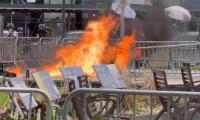The UN General Assembly proclaimed the Decade of Action for Road Safety 2011–2020 in March 2010. More than a decade has gone by since the proclamation was made. Have road accidents that cause a loss of precious lives decreased or multiplied?
November 15 was the UN’s World Day of Remembrance for Road Traffic Victims. As reported, pedestrians and motorcyclists suffer the most, especially in developing countries. Also that: ‘developing countries having one percent of the world’s vehicles show 13 percent of [the] death toll; high income countries having 40 percent of [the] world’s vehicles suffer only seven percent of all deaths’. This clearly points out the negligence of the traffic monitoring system in a country like ours.
Organising traffic has never been a priority of most of our governments. Our roads can easily be compared to a circus where stuntmen of every shade perform daily. Some reach their destinations safely, quite a few land in hospitals with multiple injuries and are crippled for life. And some unfortunately report to their Maker.
With a sharp increase in vehicular movement, especially motorcyclists, the traffic conditions on our roads have turned absolutely chaotic. The officials in whose administrative domain the responsibility of controlling traffic falls seem to turn a blind eye to the traffic jungle on the roads. They consider their job done as long as VIP movements proceed unhindered.
The administration’s apathy towards the plight of road users amounts to sending a message: each to themselves. It only speaks of poor governance. Traffic conditions act as a barometer for the efficiency of the administration. Negotiating snarled up traffic raises a question in public minds: who is in charge here?
Let’s look at the everyday scene on our roads. Some drive roughshod, changing lanes at will; others drive and simultaneously play with their cell-phones. Motorcyclists don’t restrict themselves to the left lane but zigzag at will. In countries with disciplined traffic, even holding and looking at a cell-phone when waiting on a red traffic light attracts a heavy fine.
The two main reasons for unruly traffic on our roads are: first, most of the drivers – including many educated ones among them – are not fully conversant with the traffic rules. Second, those who violate the rules are not penalised enough to pinch their pockets and deter them from violating traffic rules again. To improve traffic conditions, the administration could evolve a strategy of imposing heavy fines on traffic violations such as changing lanes, running poorly maintained vehicles, pressure-honking and parking on road turns. The amount thus collected could be contributed to the welfare fund of the traffic police, as an incentive for doing their duty diligently.
At present, the improvement of traffic conditions on our roads doesn’t surface in the administration’s list of priorities. For instance, the so-called Lahore Gate adjacent to the NAB office near Thokar Niaz Baig in Lahore has been causing great hurdles in the smooth flow of traffic for the last few years. With the initial cost of Rs25 million, this project was supposed to be completed by the end of 2019.
A year later, the Lahore Gate is complete yet its periphery is being embellished with decorative plants. The bad news for the public however is that their tax kitty has been dented by another Rs55 million since the overall cost of the project shot up from Rs25 million to Rs80 million, according to a newspaper report. This amount could have been better spent for public welfare than putting up such a tasteless monument.
The Lahore Gate is a classic example of lopsided priorities. How will this garish structure help streamline traffic or contribute to public wellbeing? Perhaps LDA bigwigs need to explain?
The writer is a freelance columnist based in Lahore.
Email: pinecity@gmail.com







